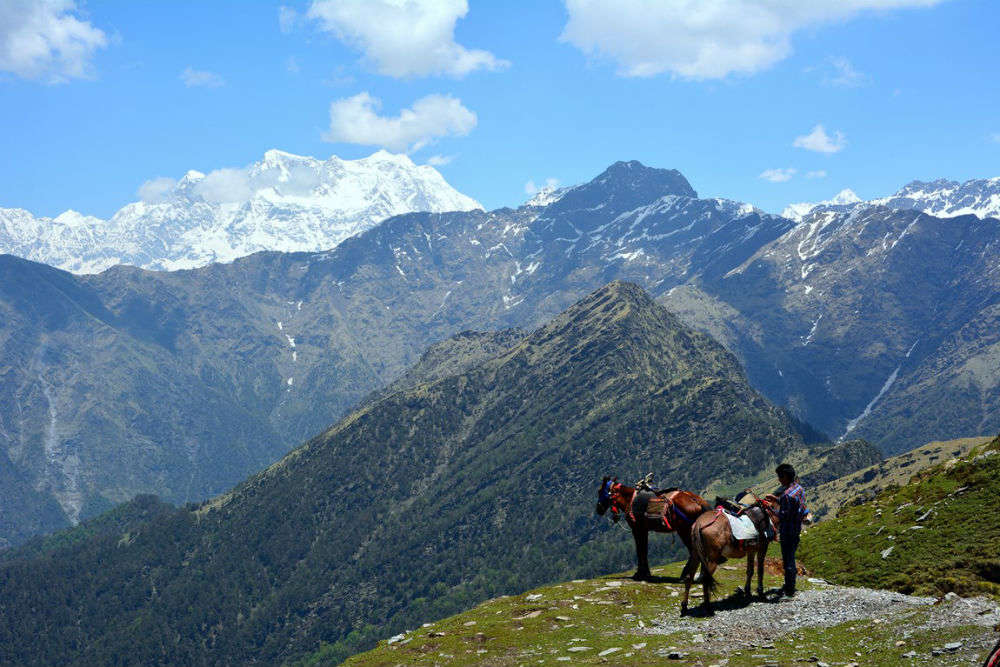Chopta Tungnath Trek – The Ultimate Himalayan Escape
Published on December 31, 2024
Nestled in the heart of Uttarakhand’s Garhwal region, the Chopta Tungnath Trek offers a perfect escape for nature lovers, adventure seekers, and spiritual travelers alike. Known for its pristine landscapes, diverse flora and fauna, and awe-inspiring views of snow-capped peaks, this trek is a testament to the untouched beauty of the Himalayas. Combining spirituality, adventure, and serenity, the trek leads to the sacred Tungnath Temple and culminates at the spectacular Chandrashila Summit. Whether you’re trekking solo or planning a group adventure, the Chopta Tungnath trek is an experience you’ll cherish forever.
A Glimpse of Chopta: The Starting Point of Serenity
Chopta, often referred to as the "Gateway to Tungnath," is a quaint hamlet surrounded by thick forests of pine, deodar, and rhododendron. Situated at an altitude of 2,680 meters (8,790 feet), Chopta is a part of the Kedarnath Wildlife Sanctuary, making it a paradise for wildlife enthusiasts and birdwatchers. The journey begins in this tranquil village, where the fresh mountain air and panoramic views set the tone for the adventure ahead.
Chopta is accessible from major cities like Delhi and Rishikesh, making it a favored destination for trekkers from across India. If you’re considering a Chopta Chandrashila Trek from Delhi, you’ll find several convenient travel options, including private cabs, buses, and tour packages tailored for this journey.
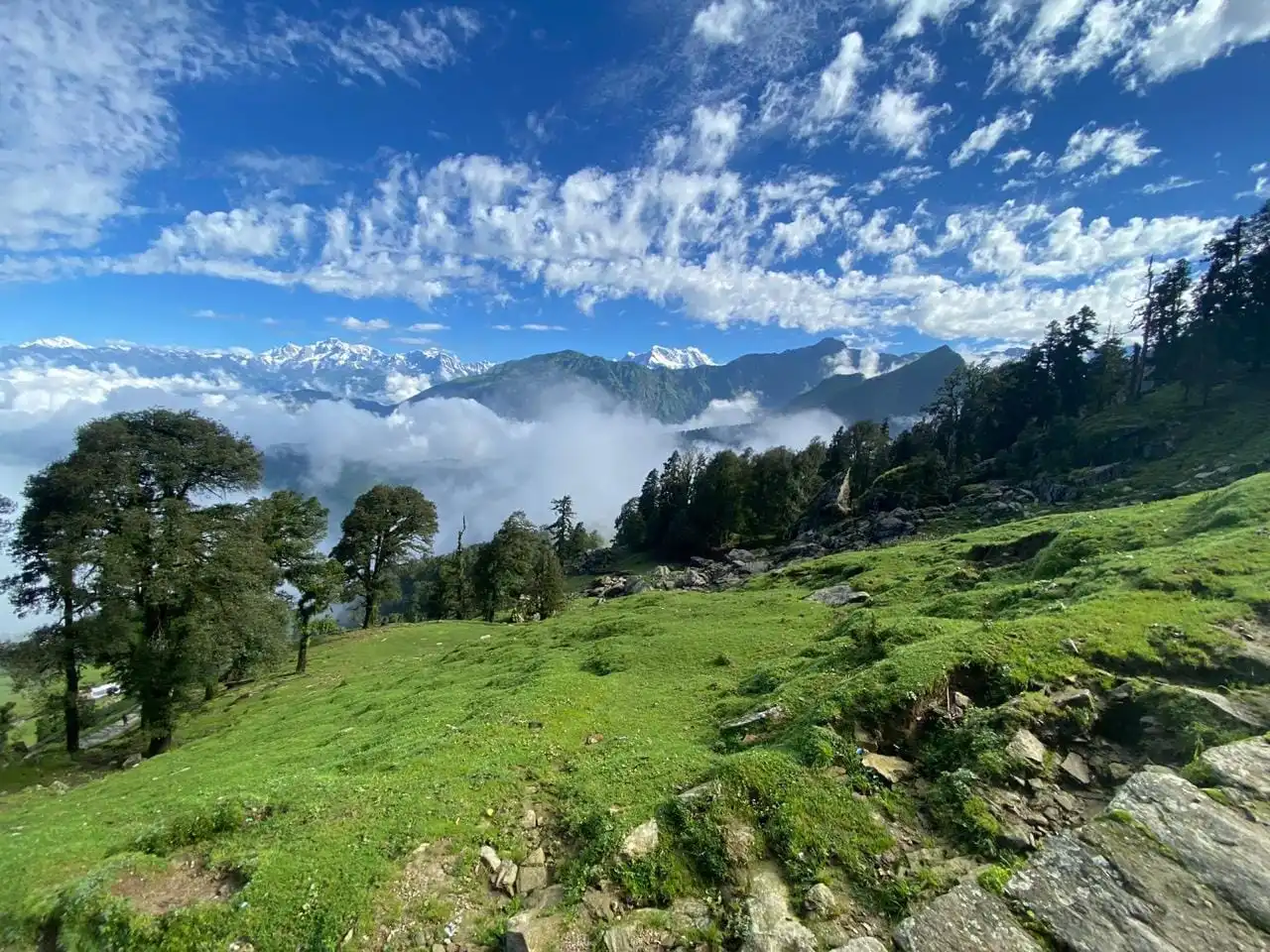
The Spiritual Journey to Tungnath Temple
The trek’s highlight is undoubtedly the Tungnath Temple, the world’s highest Shiva temple at an altitude of 3,680 meters (12,073 feet). Steeped in mythology, Tungnath is believed to be one of the Panch Kedar temples, holding immense significance for devotees of Lord Shiva. The climb to Tungnath is a relatively moderate trek, with well-marked trails winding through alpine meadows and offering breathtaking views of the Himalayan peaks.
During the trek, you’ll encounter picturesque landscapes and a sense of tranquility that’s rare to find elsewhere. As you approach the temple, the spiritual energy of the place is palpable. The ancient architecture of Tungnath, surrounded by snow in winter, makes it a sight to behold.
Chandrashila Summit: A Panoramic Himalayan Wonderland
After visiting the temple, the adventure doesn’t stop. A short but steep climb from Tungnath leads to the Chandrashila Summit, perched at an altitude of 4,000 meters (13,123 feet). The name “Chandrashila” translates to “Moon Rock,” and legend has it that Lord Rama meditated here after defeating Ravana.
The summit offers an unparalleled 360-degree view of the mighty Himalayan peaks, including Nanda Devi, Trishul, Chaukhamba, and Kedar Dome. Reaching the Chandrashila Summit Trek feels like standing on the edge of the world, surrounded by majestic mountains and endless skies. It’s an experience that stays etched in your memory long after the trek ends.

Winter vs. Summer: Choosing the Best Season for the Trek
The Chopta Chandrashila Trek is a year-round destination, but each season offers a unique experience:
-
Winter (December to February): The trail is blanketed in snow, transforming the region into a winter wonderland. The Chopta Tungnath Trek from Delhi in winter is perfect for those seeking a snow-covered adventure and serene landscapes.
-
Summer (April to June): The weather is pleasant, and the meadows come alive with vibrant wildflowers. It’s an ideal time for trekkers who prefer clear skies and lush greenery.
-
Monsoon (July to September): While the region is prone to landslides, the post-monsoon period rewards visitors with rejuvenated landscapes and a rich diversity of flora and fauna.
The Flora and Fauna of the Chopta Tungnath Trail
The trek passes through the Kedarnath Wildlife Sanctuary, home to a diverse range of flora and fauna. Trekkers can spot Himalayan monals, musk deer, and a variety of butterflies along the way. In spring, rhododendron forests burst into vibrant hues of red and pink, creating a mesmerizing backdrop.
The pristine environment makes the Chopta Tungnath Trek not just an adventure but a journey into nature’s lap, where every step reveals something extraordinary.
Planning Your Trek: What to Pack and Expect
Preparation is key to enjoying your trek. Here are some essentials to consider:
- Clothing: Layered clothing is essential, especially if you’re planning a winter trek. Carry thermals, waterproof jackets, and gloves.
- Footwear: Invest in sturdy trekking shoes with a good grip to navigate snowy or slippery trails.
- Gear: Trekking poles, headlamps, and a daypack are highly recommended.
- Food and Water: While there are small eateries along the trail, carry energy bars and a water bottle with purification tablets.
Joining a Chopta Tour Package ensures you have guides and resources to make your journey hassle-free.
The Joy of Camping Under Himalayan Skies
Camping in the Himalayas is an experience unlike any other, where the towering peaks, tranquil surroundings, and starlit nights come together to create unforgettable memories. Among the best destinations for this magical experience is Chopta, a serene hamlet in Uttarakhand. Combining breathtaking landscapes with adventure, Chopta is the gateway to the Chopta Tungnath Trek, Chandrashila Summit Trek, and more. Camping here offers a chance to reconnect with nature, unwind in the lap of the Himalayas, and experience the ultimate escape from everyday life.
Why Chopta is Perfect for Camping
Chopta, situated at an altitude of 2,680 meters (8,790 feet), is often called the "Gateway to Tungnath and Chandrashila." The region is surrounded by lush meadows, dense forests of pine and rhododendron, and an awe-inspiring view of the Himalayan ranges. Its calm atmosphere makes it an ideal camping destination for trekkers, nature lovers, and adventure enthusiasts.
With its easy accessibility and proximity to popular trekking routes like the Tungnath Temple Trek and the Chandrashila Summit Trek, Chopta is a hotspot for Himalayan adventures. Many trekking enthusiasts also choose Chopta tour packages that include guided camping experiences for a hassle-free journey.
Experiencing the Magic of Himalayan Nights
One of the highlights of camping in Chopta is experiencing the Himalayan skies after sunset. As daylight fades, the skies come alive with countless stars, creating a celestial spectacle that’s hard to find in urban areas. The crisp mountain air, combined with the serene silence, makes stargazing an unforgettable activity.
If you're embarking on a Chopta Chandrashila Trek from Delhi, camping under the Himalayan skies is a reward in itself. Whether you're a solo traveler or part of a group, the tranquility of the night under the stars is an experience that will stay with you forever.
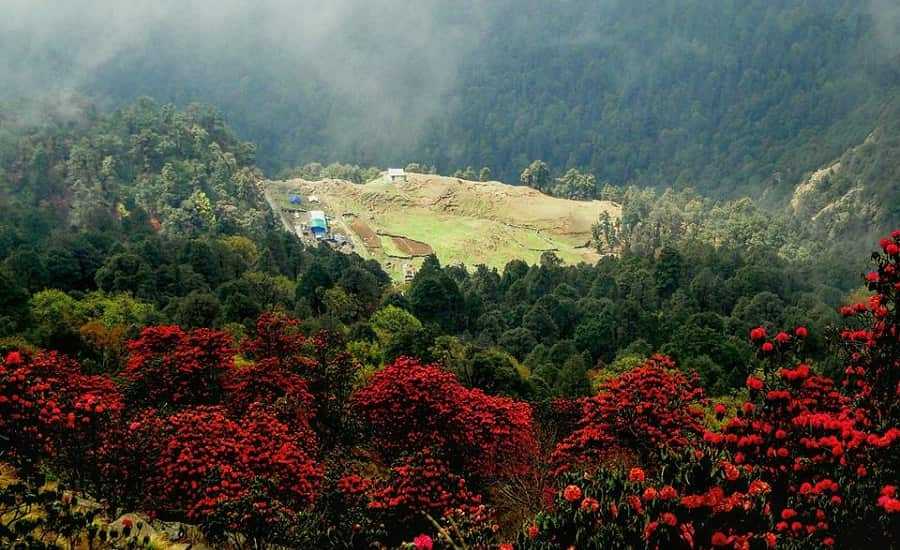
Camping Spots Around Chopta
-
Deoria Tal
Located just a short trek from Chopta, Deoria Tal is a pristine lake surrounded by forests and offering a mirror-like reflection of the Himalayan peaks. It’s a popular camping spot for trekkers who wish to soak in the natural beauty before heading toward Tungnath and Chandrashila. -
Chopta Base Camps
The base camps in Chopta provide facilities for campers and serve as the starting point for the Chopta Tungnath Trek and the Chopta Chandrashila Trek from Delhi. -
Baniyakund
A serene meadow close to Chopta, Baniyakund is another favorite spot for camping. With panoramic views of the mountains and a peaceful atmosphere, it’s ideal for those looking to escape the hustle and bustle.
The Blend of Adventure and Serenity
Camping in Chopta is not just about pitching a tent; it’s about immersing yourself in the natural surroundings. The experience is a blend of adventure and tranquility:
- Morning Hikes: Start your day with short treks around Chopta to witness a Himalayan sunrise.
- Bonfires: Gather around a bonfire in the evening, sharing stories and enjoying the warmth against the chilly mountain air.
- Wildlife Spotting: The Kedarnath Wildlife Sanctuary, which surrounds Chopta, is home to diverse flora and fauna, including the Himalayan monal, musk deer, and leopards.
Camping During the Tungnath Chandrashila Trek
For trekkers, camping is an integral part of the Tungnath Chandrashila Trek from Delhi. The journey to Tungnath, the highest Shiva temple in the world, and the Chandrashila summit is enriched by overnight stays in campsites.
Camping along the trek allows you to acclimatize while enjoying the natural beauty. The campsites are strategically placed to provide stunning views of snow-clad peaks, including Nanda Devi, Chaukhamba, and Trishul.
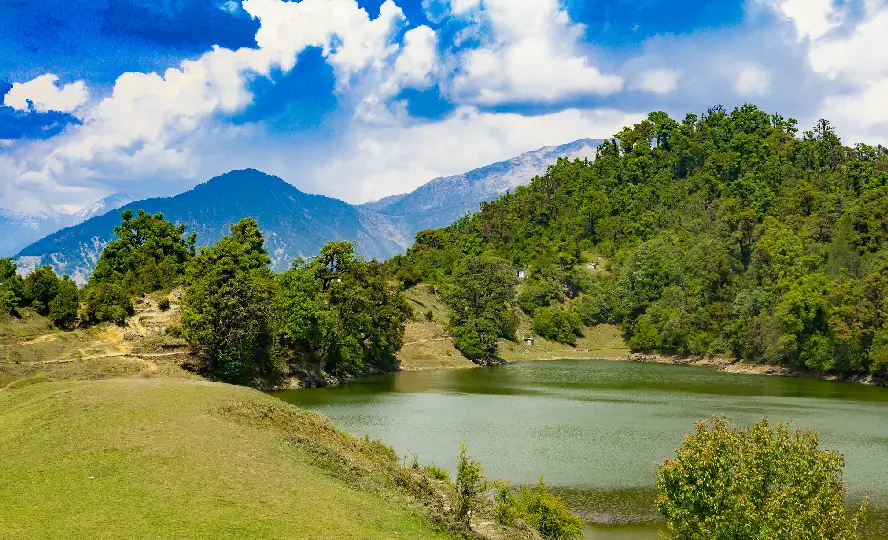
Seasons for Camping in Chopta
- Spring (March to May): The rhododendrons bloom, painting the landscape with vibrant colors. It’s an excellent time for nature photography and camping amidst lush greenery.
- Summer (June to August): Escape the heat and enjoy the pleasant weather of Chopta. The clear skies make it a great season for stargazing.
- Autumn (September to November): The post-monsoon season offers rejuvenated landscapes and clear mountain views, perfect for camping and trekking.
- Winter (December to February): The region is blanketed in snow, creating a magical setting for winter camping. The Chopta Tungnath Trek from Delhi during this time is particularly popular among snow trek enthusiasts.
Packing Essentials for Camping
To ensure a comfortable and enjoyable camping experience in Chopta, here’s a checklist of essentials:
- Clothing: Layered clothes, warm jackets, gloves, and thermal wear.
- Footwear: Waterproof and sturdy trekking shoes.
- Camping Gear: Sleeping bags, insulated mats, and a lightweight tent (if not provided by a tour package).
- Food and Water: Carry energy bars, trail mix, and reusable water bottles.
- Safety Items: Flashlights, a first-aid kit, and trekking poles.
Joining a Chopta tour package often simplifies this process, as many include all necessary camping gear.
Local Cuisine: A Taste of the Mountains
Camping in Chopta is also an opportunity to savor local delicacies. From steaming Aloo Puri to Kumaoni Raita, the food served in the campsites reflects the simplicity and warmth of Uttarakhand. After a long day of trekking, enjoying a hot, freshly-prepared meal around a bonfire adds to the charm of the experience.
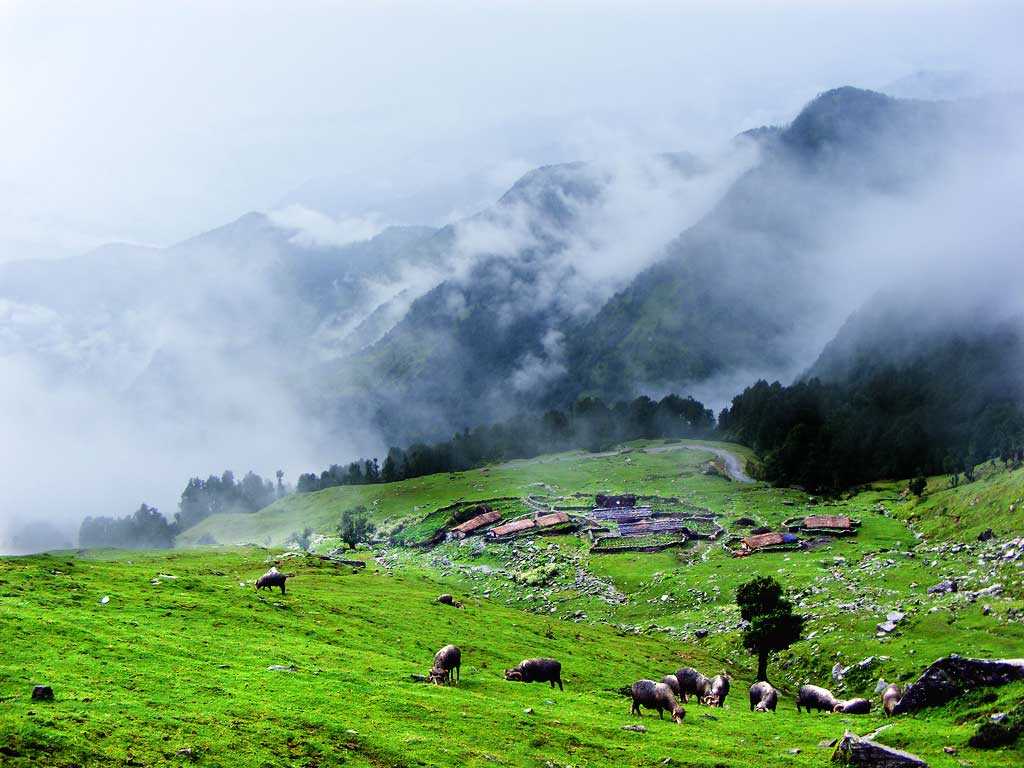
Eco-Friendly Camping Practices
Chopta is a part of the Kedarnath Wildlife Sanctuary, and preserving its pristine environment is a shared responsibility. Here are some eco-friendly practices to follow:
- Avoid using single-use plastics.
- Carry reusable water bottles and utensils.
- Leave no trace—collect and dispose of waste responsibly.
- Respect local flora and fauna by not disturbing the natural habitat.
By adopting sustainable camping practices, you contribute to preserving the beauty of Chopta for future generations.
Why Chopta Tungnath is a Photographer’s Paradise
From snow-clad peaks to verdant meadows and vibrant sunsets, the Chopta Chandrashila Trek offers endless opportunities for photography enthusiasts. Whether you’re capturing the intricate details of the Tungnath Temple or the panoramic views from Chandrashila, every frame tells a story of the Himalayas’ unparalleled beauty.
Eco-Tourism in Chopta: Preserving the Pristine Environment
Chopta is an eco-tourism destination, and efforts are being made to preserve its pristine environment. Trekkers are encouraged to practice responsible tourism by minimizing waste, avoiding single-use plastics, and respecting the local culture and wildlife.
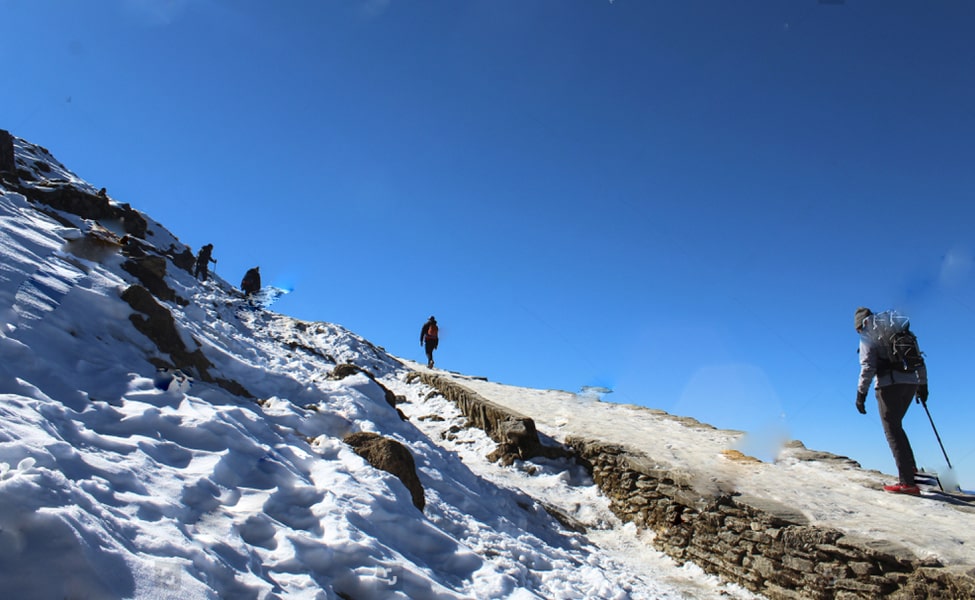
Trekking Safety Tips: Staying Prepared for Challenges
While the Chopta Tungnath Trek is considered moderate, it’s essential to stay prepared:
- Acclimatize properly to avoid altitude sickness.
- Stay hydrated and pace yourself during the trek.
- Follow the guidance of local guides, especially in winter when trails can be slippery.
Savoring the Local Cuisine: A Taste of Uttarakhand
No trip to Chopta is complete without savoring the local cuisine. From piping hot Aloo Puri to Kumaoni Raita, the food reflects the region’s rich culture. The warmth of local hospitality, combined with the flavors of Uttarakhand, adds a unique touch to your trekking experience.
Why Chopta Tungnath is the Perfect Himalayan Retreat
The Chopta Tungnath Trek is more than just a trek—it’s a journey that rejuvenates your mind, body, and soul. Whether you’re seeking adventure, spiritual fulfillment, or a break from the chaos of city life, this trek offers it all. The serene environment, coupled with breathtaking vistas and the spiritual aura of Tungnath, makes it a perfect Himalayan retreat.
Wildlife Encounters on the Trek: A Nature Lover's Delight
Trekking through Chopta and its surrounding trails isn’t just about the breathtaking views and serene landscapes; it’s also an opportunity to witness the diverse wildlife that calls the Himalayas home. Whether you're embarking on the Chopta Tungnath Trek, the Chandrashila Summit Trek, or exploring the Kedarnath Wildlife Sanctuary, encounters with the local fauna add an exhilarating layer to the adventure.

The Kedarnath Wildlife Sanctuary: A Biodiversity Haven
Chopta lies within the Kedarnath Wildlife Sanctuary, one of the richest biodiversity zones in Uttarakhand. The sanctuary, sprawling across 975 square kilometers, is a treasure trove of flora and fauna. For trekkers undertaking the Tungnath Temple Trek or the Chopta Chandrashila Trek, the sanctuary provides a perfect backdrop filled with the melodies of chirping birds and rustling leaves.
Key Fauna in the Sanctuary
- Himalayan Monal: The state bird of Uttarakhand, the Himalayan Monal, is a frequent sight on these treks. Its vibrant plumage is a treat for birdwatchers.
- Musk Deer: Known for its elusive nature, spotting this rare and shy creature is a delight for wildlife enthusiasts.
- Leopards: Though sightings are rare, leopards are an integral part of the sanctuary's ecosystem.
- Barking Deer and Himalayan Tahr: These animals are often spotted grazing in the alpine meadows during the trek.
- Birdlife: With over 200 bird species, including the Snow Partridge and Himalayan Griffon, the sanctuary is a haven for bird lovers.
Wildlife Along the Chopta Tungnath Trek
The Chopta Tungnath Trek offers a close encounter with the region’s wildlife. As you ascend through dense forests of pine, oak, and rhododendron, keep your eyes peeled for playful langurs swinging through the trees and small mammals like foxes and martens. The serene environment often makes it easier to spot these creatures going about their daily activities.

Birdwatching on the Chandrashila Summit Trek
The Chandrashila Summit Trek is particularly famous for birdwatching. The higher altitudes provide a habitat for rare and migratory birds. Early mornings and evenings are the best times to spot these feathered wonders.
Common Birds to Look Out For:
- Cheer Pheasant
- Koklass Pheasant
- Yellow-billed Blue Magpie
- Himalayan Woodpecker
For those taking the Tungnath Chandrashila Trek from Delhi, a good pair of binoculars and a bird guide can enhance the experience.
Seasonal Wildlife Encounters
The time of year significantly impacts the kind of wildlife you’re likely to encounter:
- Spring and Summer (March to June): This is the best time for spotting herbivores like deer and the Himalayan Tahr, as they graze in the meadows. The forests come alive with bird calls, making it an ideal season for birdwatching.
- Monsoon (July to September): Though trekking is challenging due to rains, the sanctuary is lush and teeming with life. Insects, butterflies, and amphibians like frogs are more visible.
- Autumn (October to November): The clear skies and rejuvenated landscapes post-monsoon provide excellent visibility for spotting wildlife.
- Winter (December to February): The snow brings out a different set of animals, including foxes and snow partridges. The Chopta Tungnath Trek from Delhi during this season offers a unique wildlife experience.

Tips for Ethical Wildlife Encounters
- Maintain Silence: Animals are more likely to show themselves in quieter environments. Avoid loud conversations or playing music.
- Stay on the Trail: Straying from marked trails can disturb habitats and increase the risk of encountering wild animals unprepared.
- Avoid Feeding Animals: Feeding wildlife disrupts their natural foraging behavior and can make them dependent on humans.
- Carry a Camera: Wildlife photography is a great way to capture memories, but use zoom lenses to avoid getting too close.
- Travel with a Guide: Local guides are knowledgeable about wildlife behavior and can enhance your trekking experience with their insights.
Wildlife Photography Opportunities
The Chopta Chandrashila Trek from Delhi is a dream destination for photographers. The combination of majestic Himalayan peaks and the chance to capture animals in their natural habitat is unparalleled. Early mornings offer the best lighting and increased activity among the wildlife.
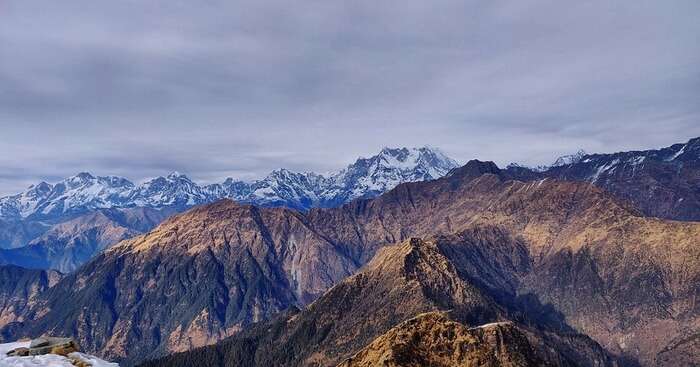
A Trekker's Account of a Wildlife Encounter
While on the Tungnath Temple Trek, a trekker shared an unforgettable experience:
"We were trekking through the dense rhododendron forest when a flash of iridescent blue caught my eye. It was a Himalayan Monal, perched gracefully on a rock. Its vivid colors stood out against the green backdrop, and as it moved, it seemed to dance with the wind. Seeing such a beautiful bird in its natural habitat was the highlight of my trek."
Safety Precautions During Wildlife Encounters
While spotting wildlife is exciting, it’s essential to take safety precautions:
- Keep a Safe Distance: Never approach or try to touch wild animals.
- Avoid Strong Scents: Perfumes or scented lotions can attract or disturb animals.
- Store Food Securely: Pack food in airtight containers to avoid attracting wildlife to your campsite.
- Know Emergency Procedures: Familiarize yourself with what to do in case of an encounter with a predator.
Why Wildlife Adds Value to the Chopta Treks
The presence of diverse wildlife enriches the trekking experience in Chopta. Observing animals in their natural habitats fosters a deeper connection with nature and highlights the importance of conservation efforts. It transforms the trek into not just a physical journey but also a spiritual and educational one.
For those opting for Chopta tour packages, many include wildlife exploration as part of the itinerary, ensuring a well-rounded adventure.
Weather Patterns to Expect During the Trek: Insights for a Seamless Adventure
The Chopta Tungnath Trek and Chandrashila Summit Trek are some of the most sought-after Himalayan adventures. Known for their scenic beauty, these treks promise a captivating experience through the alpine wilderness. However, understanding the weather patterns along these routes is vital for a safe and enjoyable journey. Let’s dive into what to expect during each season and how to prepare for it.
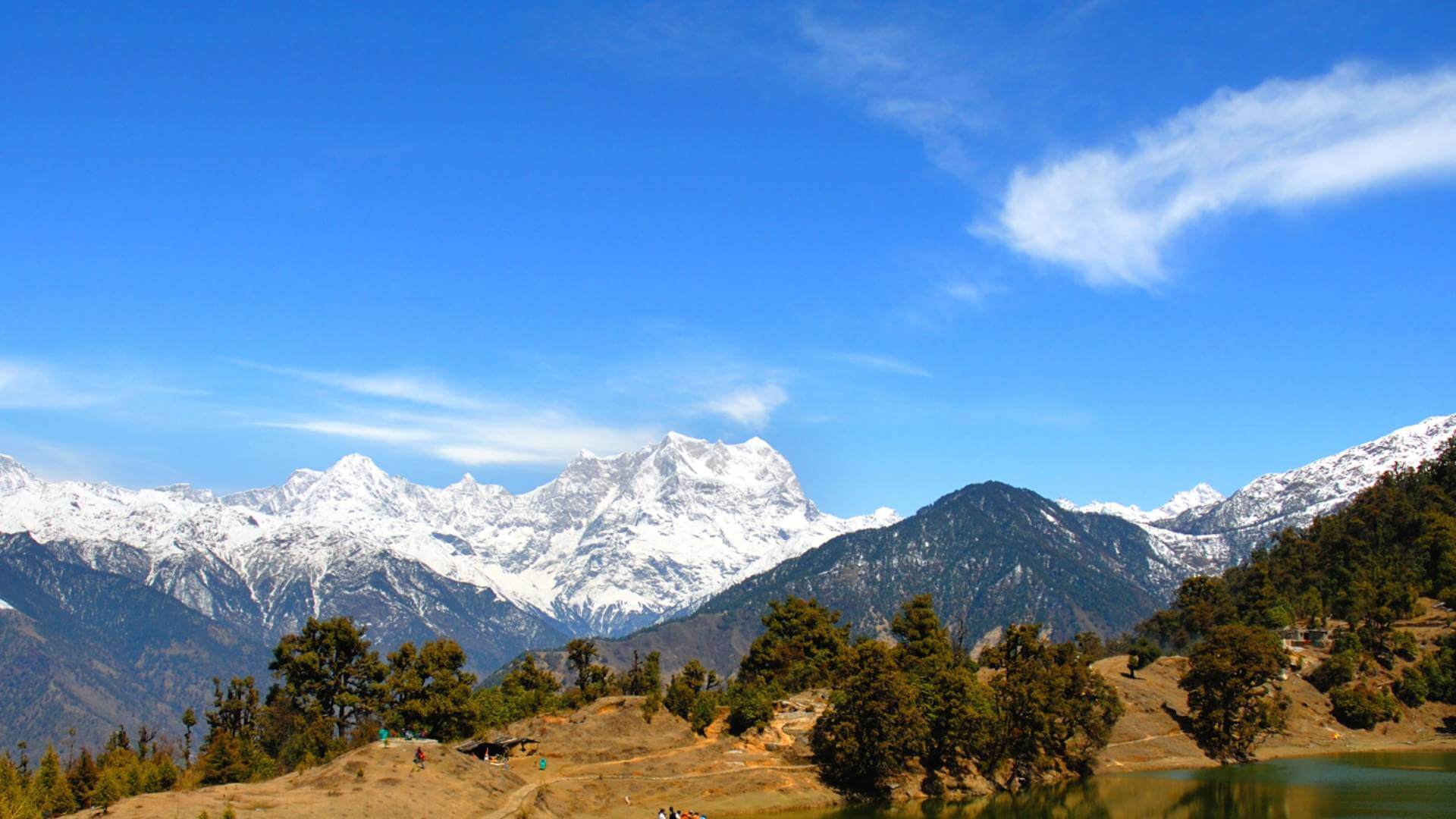
Understanding the Seasonal Weather in Chopta
Chopta is a year-round destination, but its weather varies significantly with the seasons. Whether you’re planning the Tungnath Temple Trek or the Chopta Chandrashila Trek from Delhi, being prepared for the specific conditions is key to enjoying the journey.
Spring (March to April): A Blooming Paradise
Spring transforms Chopta into a vibrant haven, with rhododendrons painting the forests in shades of pink and red.
- Temperature: Daytime temperatures range from 10°C to 20°C, while nights can dip to 2°C to 5°C.
- Weather: Expect mild and pleasant weather with clear skies, perfect for trekking.
- Trekking Tips: Carry light woolens for the evenings and plenty of water to stay hydrated.
Spring is an excellent time for the Chopta Tungnath Trek as the trails are snow-free, and the blooming flora enhances the trek’s beauty.
Summer (May to June): Ideal for High-Altitude Treks
Summer is peak trekking season, especially for the Chandrashila Trek and Tungnath Temple Trek.
- Temperature: Day temperatures hover around 15°C to 25°C, with nights cooling down to 5°C to 10°C.
- Weather: The skies remain mostly clear, offering unobstructed views of Himalayan peaks like Nanda Devi and Trishul.
- Trekking Tips: Wear lightweight, breathable clothing and use sunscreen to protect against UV rays.
This is also the best season for those planning the Tungnath Chandrashila Trek from Delhi, as the roads are accessible and the weather is stable.
Monsoon (July to September): A Green Symphony
The monsoon transforms Chopta into a lush green paradise, but it also brings challenges.
- Temperature: Daytime temperatures are between 10°C and 20°C, with nights ranging from 5°C to 10°C.
- Weather: Frequent rainfall makes the trails slippery, and the region is prone to landslides.
- Trekking Tips: Carry waterproof gear, sturdy trekking shoes with a good grip, and insect repellent.
The Chopta Chandrashila Trek from Delhi during monsoon requires careful planning, but the verdant landscapes make it worth the effort.
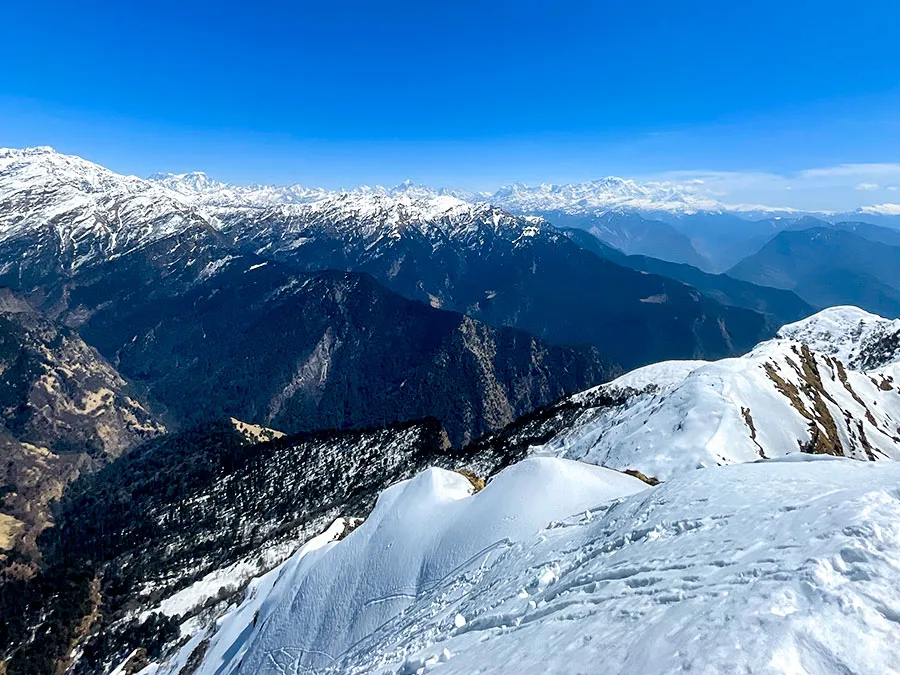
Autumn (October to November): Crisp and Clear
Autumn is another popular time for trekking, thanks to its clear skies and pleasant weather.
- Temperature: Day temperatures range from 10°C to 18°C, with nights dipping to 0°C to 5°C.
- Weather: Post-monsoon clarity offers stunning views of the surrounding peaks, making it an ideal time for photography.
- Trekking Tips: Layer up, as temperatures can drop significantly at higher altitudes during evenings.
Autumn is perfect for the Chopta Tungnath Trek from Delhi, combining accessibility with breathtaking vistas.
Winter (December to February): A Snowy Wonderland
Winter transforms Chopta into a snowy wonderland, attracting adventure seekers for the Chandrashila Summit Trek.
- Temperature: Daytime temperatures are between 0°C and 10°C, while nights can plunge to -10°C.
- Weather: Frequent snowfall blankets the trails, creating a magical trekking experience.
- Trekking Tips: Carry heavy woolens, snow boots, and trekking poles for stability.
The Tungnath Temple Trek during winter offers a unique challenge but rewards trekkers with unparalleled beauty and solitude.
Preparing for Sudden Weather Changes
The Himalayan weather can be unpredictable, with conditions changing rapidly. Here are some tips to prepare for surprises:
- Layering is Key: Wear layers to adjust to sudden temperature changes.
- Rain Protection: Always carry a rain jacket or poncho, even in the dry season.
- Monitor Weather Updates: Check forecasts regularly, especially if planning the Chopta Chandrashila Trek from Delhi.
- Stay Informed: Consult with local guides for real-time weather conditions.
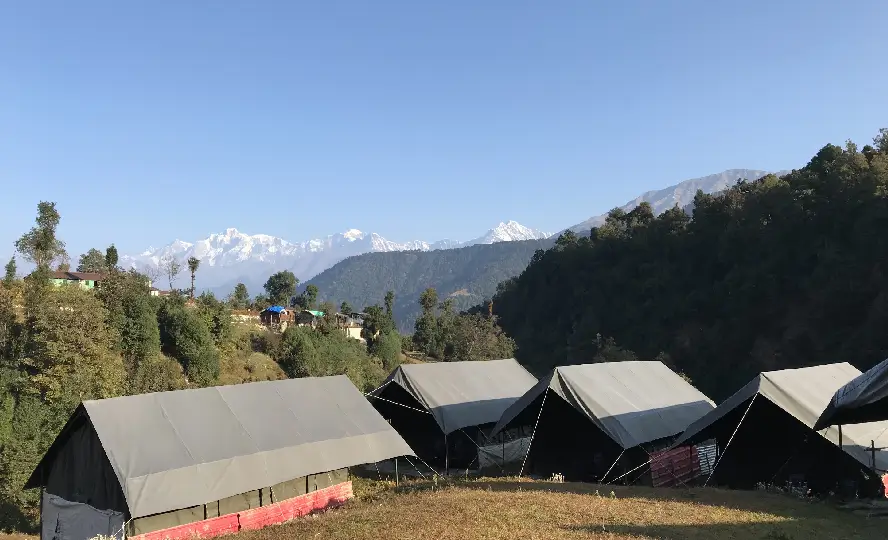
Gear Recommendations for Different Seasons
No matter when you choose to trek, having the right gear ensures comfort and safety:
- Spring and Summer: Lightweight clothing, sturdy trekking shoes, and a hat.
- Monsoon: Waterproof jacket, quick-dry clothing, and anti-slip trekking poles.
- Autumn and Winter: Thermal layers, snow boots, and gloves.
Highlights of Trekking in Each Season
Each season offers its unique charm, making the Chopta treks versatile and captivating:
- Spring: Best for nature lovers seeking vibrant landscapes.
- Summer: Perfect for families and beginners due to stable weather.
- Monsoon: Ideal for solitude and lush greenery.
- Autumn: Great for photographers and trekkers seeking crisp views.
- Winter: A challenge for seasoned adventurers with snowy trails.
Real-Life Experience: A Winter Trekker's Tale
"During my Chopta Tungnath Trek in December, the snow-covered trails felt like stepping into a dream. The crisp mountain air and the sight of the Tungnath Temple amidst a snowy landscape were unforgettable. While the cold was biting, the beauty of the trek made every moment worthwhile. Proper gear and preparation made it an adventure of a lifetime."
Weather-Related Challenges and How to Overcome Them
Trekking in the Himalayas comes with its share of weather-related challenges.
- Altitude Sickness: Stay hydrated and acclimatize gradually.
- Slippery Trails: Use trekking poles and shoes with a strong grip.
- Cold Nights: Invest in a good-quality sleeping bag and thermals.
Proper planning can make your journey on the Tungnath Temple Trek or Chandrashila Summit Trek seamless and enjoyable.
Monsoon Adventures: Trekking Through Verdant Landscapes
Monsoon in the Himalayas transforms the region into a lush, green paradise, offering a surreal experience for adventure seekers. The Chopta Tungnath Trek and Chandrashila Summit Trek become even more magical as rain brings life to the flora and rejuvenates the landscapes. If you’re someone who craves a refreshing escape amidst misty mountains and cascading streams, monsoon trekking through Chopta's verdant trails is an adventure worth embarking on.
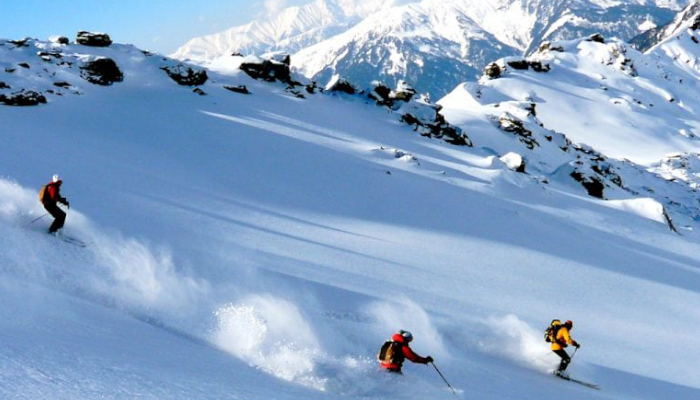
Why Trek During the Monsoon?
While many avoid trekking during the monsoon due to unpredictable weather, the season offers unparalleled beauty and tranquility.
- Verdant Beauty: The landscapes turn into a green wonderland, with dense forests and meadows coming alive.
- Fewer Crowds: Monsoon trekking ensures solitude, making it perfect for those seeking peace.
- Unique Experiences: Witness mist-covered peaks, gushing waterfalls, and blooming wildflowers.
Top Monsoon Treks Around Chopta
-
Tungnath Temple Trek
This trek leads to the world’s highest Shiva temple, offering breathtaking views of the mist-shrouded Himalayas. The trails, lined with rain-kissed foliage, make the journey enchanting. -
Chandrashila Summit Trek
The summit offers panoramic views of the Himalayan peaks, often emerging dramatically through the clouds during the monsoon. -
Chopta Chandrashila Trek from Delhi
Ideal for those traveling from Delhi, this trek combines the beauty of Chopta, Tungnath, and Chandrashila into a seamless adventure. -
Deoria Tal Trek
The monsoon enhances the charm of Deoria Tal, a serene lake reflecting the surrounding forests and peaks.
Preparing for Monsoon Treks
Monsoon trekking requires thorough preparation to tackle the challenges posed by rain-soaked trails and unpredictable weather.
1. Gear Essentials
- Waterproof Gear: Invest in a quality rain jacket, poncho, and waterproof backpack cover.
- Sturdy Footwear: Use trekking shoes with excellent grip to navigate slippery trails.
- Trekking Poles: Essential for stability on wet and uneven terrain.
2. Clothing
- Opt for quick-drying clothes and carry extra layers for warmth.
- Avoid cotton, as it retains moisture and becomes heavy.
3. Backpack Must-Haves
- First aid kit with antiseptic and anti-fungal creams.
- Insect repellent to ward off mosquitoes and leeches.
- High-energy snacks and hydration packs.
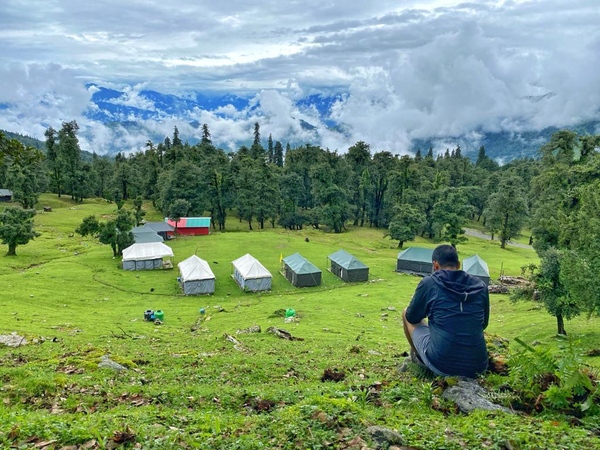
Challenges of Monsoon Trekking
1. Slippery Trails
Rain can make trails muddy and slippery. Use trekking poles and tread cautiously.
2. Leeches
Leeches are common in forested areas during monsoons. Wearing high-ankle boots and using salt or lemon to remove them can help.
3. Landslides and Delays
Roads leading to Chopta can be affected by landslides. Always keep buffer time in your itinerary.
Despite these challenges, the beauty of the monsoon makes it worth the effort, especially for treks like the Chopta Tungnath Trek from Delhi.
The Monsoon Experience: A Trekker’s Tale
"Last monsoon, I embarked on the Chopta Chandrashila Trek with a group of friends. The rain added an ethereal touch to the journey—lush meadows glistened with raindrops, and the scent of wet earth filled the air. The climb to Tungnath was surreal, with clouds swirling around us. At Chandrashila, the peaks peeked through the mist, creating a moment of pure magic. Despite the occasional challenges, the trek remains one of my most memorable adventures."
Wildlife Encounters During Monsoon
The monsoon breathes life into Chopta’s flora and fauna, making it a haven for wildlife enthusiasts.
- Birdwatching: Spot Himalayan monals, pheasants, and other colorful birds amidst the rain-soaked forests.
- Animal Sightings: Keep an eye out for musk deer, Himalayan foxes, and langurs.
- Flora: Wildflowers and medicinal plants thrive during the monsoon, adding color to the trails.
Best Practices for a Safe Monsoon Trek
- Stay Updated: Check weather forecasts and road conditions before starting your journey.
- Hire a Guide: Local guides are familiar with the terrain and can ensure a safer trek.
- Travel Insurance: Opt for travel insurance that covers adventure activities.
Why Choose Chopta for Monsoon Trekking?
Chopta, often referred to as the “Mini Switzerland of Uttarakhand,” offers a perfect blend of natural beauty and accessible trekking routes. Its proximity to Delhi makes it a favorite for treks like the Tungnath Chandrashila Trek from Delhi.
- Accessibility: Chopta is well-connected, even during the monsoon, with regular bus and taxi services.
- Accommodation Options: From campsites to cozy lodges, Chopta offers various options for trekkers.
- Scenic Trails: The treks are moderately challenging, making them suitable for beginners and experienced trekkers alike.

Benefits of Monsoon Trekking
- Rejuvenation: The lush greenery and fresh mountain air rejuvenate the mind and body.
- Photography Opportunities: Misty landscapes and dramatic skies make for stunning photographs.
- Cultural Experience: Monsoon is a time for local festivals, giving trekkers a glimpse into the region’s culture.
Monsoon-Specific Trekking Packages
For those looking to experience the magic of monsoon trekking, various Chopta tour packages cater to different preferences and budgets.
- Weekend Packages: Perfect for short getaways, including the Chopta Tungnath Trek from Delhi.
- Customized Itineraries: Tailored for groups, including stops at Tungnath and Chandrashila.
- Adventure Packages: For thrill-seekers, including activities like camping and exploring Deoria Tal.
Post-Monsoon Bliss
As the monsoon clouds begin to recede, Chopta emerges like a freshly painted canvas, drenched in vibrant hues and brimming with life. Nestled in the lap of Uttarakhand’s Kedarnath Wildlife Sanctuary, this picturesque destination transforms into a paradise during the post-monsoon season. The air is crisp, the trails are lush, and the landscapes glisten under the soft glow of the sun. For nature lovers, adventure seekers, and peace enthusiasts, Chopta in the post-monsoon months offers an unparalleled experience that rejuvenates the soul and ignites the spirit of exploration.
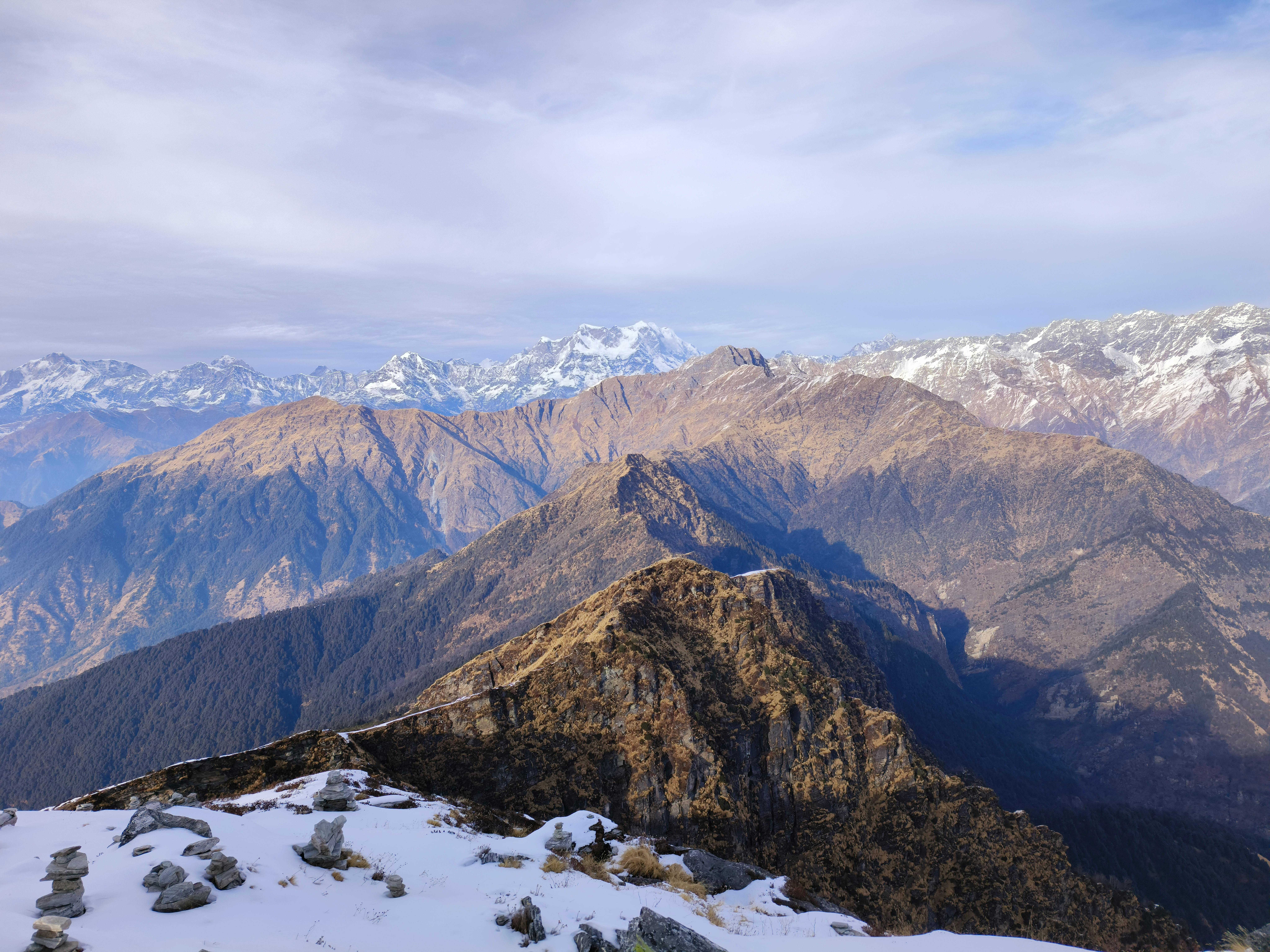
The Allure of Post-Monsoon Chopta
Post-monsoon is arguably the best time to visit Chopta. After weeks of rain, the region bursts into life, showcasing its true beauty. The dense forests of oak and rhododendron trees are at their greenest, the rivers swell with crystal-clear water, and the meadows are carpeted with wildflowers. Every corner of Chopta exudes freshness, making it an ideal escape for those seeking solace in nature.
The weather during this time is nothing short of perfect—cool yet comfortable, with clear skies offering uninterrupted views of the majestic Himalayan peaks. Whether you’re trekking through the trails or simply sitting by a stream, the post-monsoon ambiance envelops you in a sense of calm and wonder. It’s no wonder that Chopta has earned its reputation as one of the most serene destinations in the Indian Himalayas.
Lush Greenery and Vibrant Landscapes
One of the standout features of post-monsoon Chopta is its verdant beauty. The monsoon rains breathe new life into the region, turning the already stunning landscapes into a riot of greens and blues. The dense forests, which form a natural canopy along the trekking routes, are teeming with life. You’ll find moss-covered rocks, sparkling streams, and patches of wildflowers adding splashes of color to the scenery.
Walking through these trails feels like stepping into a fairytale. The rustling leaves, chirping birds, and gentle hum of flowing water create a symphony of sounds that soothe the mind. Every step reveals a new vista—be it a hidden waterfall cascading down the hills or a panoramic view of snow-capped peaks piercing the horizon. For photographers, this is a dream come true, as every frame captures the raw beauty of nature.

Crystal-Clear Views of the Himalayas
Post-monsoon is also the time when the skies clear up, offering breathtaking views of the Himalayan range. From Chopta, you can marvel at iconic peaks like Nanda Devi, Trishul, and Kedarnath standing tall against the azure sky. These towering giants seem almost close enough to touch, their snow-clad summits glowing under the golden sunlight.
For trekkers, the Chandrashila Summit Trek becomes even more rewarding during this season. As you ascend to the summit, the panoramic views of the surrounding peaks leave you awestruck. The clarity of the air allows you to see far beyond the immediate landscape, creating a sense of boundless freedom. Whether you’re an avid mountaineer or a casual traveler, witnessing these vistas is an experience you’ll never forget.
A Haven for Birdwatchers
Chopta is renowned for its rich avian diversity, and the post-monsoon season takes birdwatching to another level. The monsoon rains attract migratory birds, while resident species become more active as they prepare for the upcoming winter. This makes Chopta a hotspot for ornithologists and casual birdwatchers alike.
During this time, you can spot some of the region’s most iconic birds, including the Himalayan Monal, Koklass Pheasant, and Kalij Pheasant. Their iridescent plumage shines brightly against the lush green backdrop, making them easier to spot. Additionally, smaller birds like minivets, flycatchers, and warblers flit about the trees, filling the air with their melodious calls. For anyone passionate about wildlife, Chopta in the post-monsoon season is nothing short of a haven.

Trekking Trails at Their Best
If you’re a trekking enthusiast, there’s no better time to explore Chopta than in the post-monsoon months. The trails are well-defined, free from the mudslides and slippery patches that characterize the monsoon season. At the same time, the vegetation remains lush, providing shade and adding to the scenic beauty of the routes.
Two of the most popular treks in Chopta—the Tungnath Temple Trek and the Chandrashila Summit Trek—are particularly enchanting during this season. The path to Tungnath, one of the highest Shiva temples in the world, winds through dense forests and open meadows, culminating in a spiritual and visual feast. Meanwhile, the Chandrashila Summit Trek rewards adventurers with sweeping views of the Himalayas, making the effort worthwhile.
For those seeking shorter hikes, there are plenty of options around Chopta itself. Local guides can lead you to lesser-known trails where you can immerse yourself in the tranquility of nature without encountering large crowds. Each trail offers something unique, whether it’s a secluded waterfall, a quiet grove, or a vantage point overlooking the valley.
Cultural Immersion Amidst Natural Beauty
Beyond its natural wonders, Chopta also offers a glimpse into the rich cultural heritage of Uttarakhand. The post-monsoon season coincides with several local festivals and celebrations, giving visitors a chance to witness traditional customs and rituals firsthand. Villages near Chopta come alive with music, dance, and vibrant attire, reflecting the warmth and hospitality of the local communities.
Interacting with the villagers provides a deeper understanding of their way of life. Many homestays and guesthouses in the area are run by locals who are eager to share their stories and traditions. You might learn how to cook Garhwali delicacies, participate in folk dances, or hear tales of ancient legends passed down through generations. These interactions add a layer of authenticity to your journey, making it not just a physical adventure but also a cultural exploration.

Adventure Beyond Trekking
While trekking dominates the itinerary for most visitors, Chopta offers other exciting activities during the post-monsoon season. Camping under the starlit sky is a must-do experience, especially since the nights are cool and the skies are clear. Imagine falling asleep to the sound of crickets and waking up to the first rays of sunlight filtering through the trees.
Rock climbing, rappelling, and exploring hidden caves are other adrenaline-pumping activities available in the region. These adventures cater to thrill-seekers looking to push their limits while surrounded by the pristine beauty of Chopta. Even if you prefer a more relaxed pace, simply wandering through the forests or meditating by a stream can be equally fulfilling.
Sustainable Travel and Eco-Friendly Practices
As Chopta grows in popularity, it’s crucial to adopt sustainable travel practices to preserve its natural beauty. The post-monsoon season, with its abundant flora and fauna, highlights the importance of conservation efforts. Visitors are encouraged to minimize their environmental impact by avoiding littering, respecting wildlife, and supporting eco-friendly accommodations.
Many local organizations and tour operators prioritize sustainability, offering initiatives such as waste management programs and tree-planting drives. By choosing responsible tourism options, travelers can contribute to the preservation of Chopta’s delicate ecosystem while enjoying its splendor.
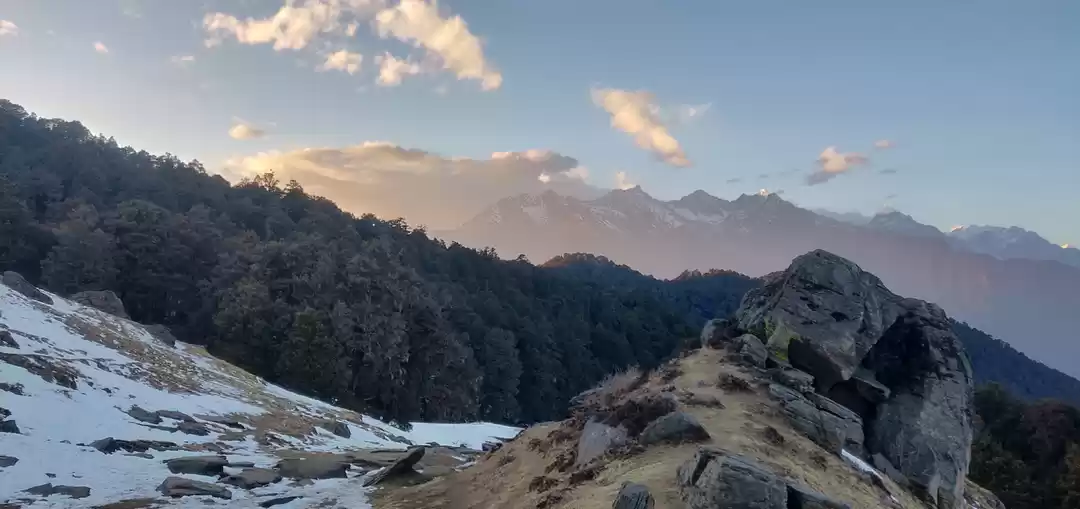
FAQs on Chopta Tungnath Trek – The Ultimate Himalayan Escape
1. What is the Chopta Tungnath Trek?
The Chopta Tungnath Trek is a scenic Himalayan trek that takes you to the Tungnath Temple, the highest Shiva temple in the world, and further to the Chandrashila Summit, offering breathtaking views of the surrounding peaks.
2. Where is Chopta located?
Chopta is a small hill station in the Rudraprayag district of Uttarakhand, India. It is the base point for the Tungnath and Chandrashila treks.
3. What is the best time to visit Chopta Tungnath Trek?
The trek is ideal between April to June and September to November. For snow trekking, December to February is the best time.
4. How difficult is the Chopta Tungnath Trek?
The trek is considered moderate, making it suitable for beginners with basic fitness levels and experienced trekkers alike.
5. How long is the trek from Chopta to Tungnath?
The trek from Chopta to Tungnath is approximately 3.5 kilometers.
6. How far is Chandrashila from Tungnath?
The trek from Tungnath Temple to Chandrashila Summit is an additional 1.5 kilometers.
7. Can I do the Chopta Tungnath Trek in one day?
Yes, the trek can be completed in a day. Starting early from Chopta allows you to trek to Tungnath and Chandrashila and return the same day.
8. Is camping allowed on the Chopta Tungnath Trek?
Yes, camping is allowed in designated areas around Chopta. Several Chopta tour packages include camping experiences.
9. What is the altitude of Tungnath and Chandrashila?
Tungnath is situated at an altitude of 3,680 meters, while Chandrashila Summit is at 4,130 meters.
10. Are there any age restrictions for the trek?
The trek is suitable for people of all ages, but children and the elderly should have reasonable fitness levels.
11. What should I pack for the trek?
Carry essentials like warm clothing, trekking shoes, a raincoat, sunscreen, and a first aid kit.
12. Do I need a guide for the Chopta Tungnath Trek?
The trails are well-marked, so a guide is not mandatory. However, hiring one ensures a safer and more enriching experience, especially during winter.
13. Is the Chopta Tungnath Trek safe for solo travelers?
Yes, it is considered safe for solo travelers due to its popularity and well-trodden paths.
14. What are the main attractions on the trek?
The main attractions are the Tungnath Temple, Chandrashila Summit, Rhododendron forests, and panoramic views of Himalayan peaks like Nanda Devi and Trishul.
15. Are there food and water facilities on the trek?
Basic food and water facilities are available in Chopta and at small dhabas along the trek. However, carrying your own water bottle is advisable.
16. How can I reach Chopta from Delhi?
You can reach Chopta by taking a train or flight to Haridwar or Dehradun, followed by a road journey. Many Chopta Tungnath Trek from Delhi packages offer direct transport.
17. Can I experience snow on the Chopta Tungnath Trek?
Yes, during the winter months (December to February), the region is covered in snow, making it a popular snow trek destination.
18. Are there any permits required for the trek?
Currently, no special permits are required for the Chopta Tungnath Trek, but checking with local authorities is recommended.
19. Are there accommodations in Chopta?
Yes, Chopta offers various accommodations, including budget lodges, homestays, and campsites.
20. Is mobile network connectivity available in Chopta?
Network connectivity is limited, with occasional signals for BSNL and Jio. It's better to inform your contacts beforehand.
21. What wildlife can I encounter on the trek?
The trek offers opportunities to spot Himalayan monals, musk deer, and other wildlife, especially in the Kedarnath Wildlife Sanctuary.
22. Is Chandrashila Summit accessible during monsoon?
While trekking during monsoon is possible, it is challenging due to slippery trails and unpredictable weather. Hiring a guide is recommended.
23. What are the temperature ranges during the trek?
Temperatures vary from 10°C to 20°C in summer and can drop to -15°C in winter.
24. Are there group trekking options available?
Yes, several Chopta tour packages offer group trekking options, including Chopta Chandrashila Trek from Delhi.
25. What makes the Chopta Tungnath Trek unique?
The trek's uniqueness lies in its combination of spiritual, natural, and adventurous elements, offering mesmerizing views, cultural significance, and an unforgettable Himalayan escape.

